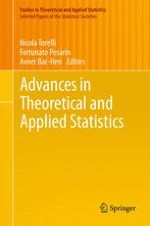2013 | OriginalPaper | Chapter
43. Clusters and Equivalence Scales
Authors : Gustavo De Santis, Mauro Maltagliati
Published in: Advances in Theoretical and Applied Statistics
Publisher: Springer Berlin Heidelberg
Activate our intelligent search to find suitable subject content or patents.
Select sections of text to find matching patents with Artificial Intelligence. powered by
Select sections of text to find additional relevant content using AI-assisted search. powered by
